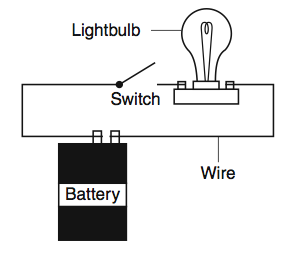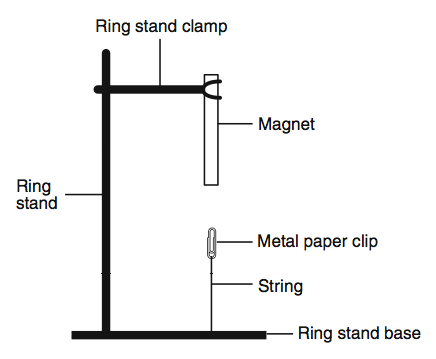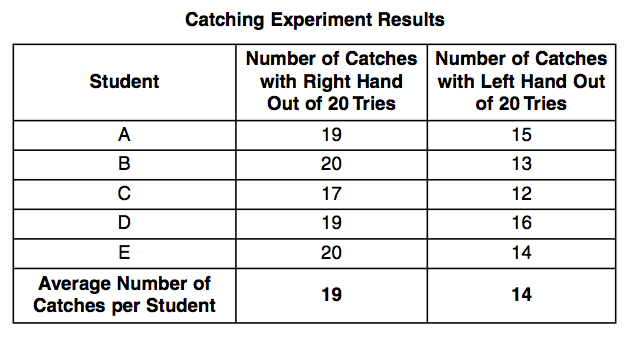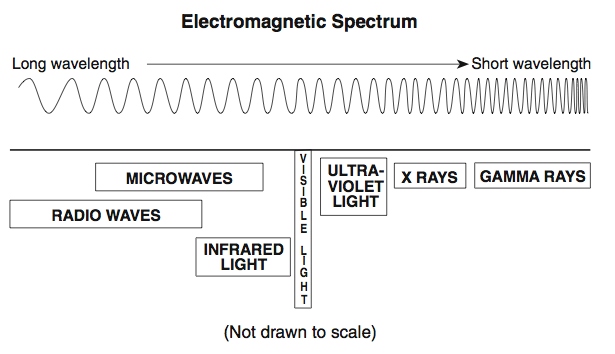Science Exam Part 2
(161).jpg)
Practice Science test part 2
Questions and Answers
- 1.
Directions (46–81): Record your answers in the space provided below each question. Base your answers to questions 46 and 47 on the information below and on your knowledge of science. The diagram below shows the results of a fruit fly activity that took place over a 20-day period. On day 1, four fruit flies were placed in a jar containing food and water. The jar had a cover that allowed enough air exchange for the fruit flies to survive, but would not allow them to escape or other flies to enter. The number of flies observed in the jar during the 20-day period is shown. 46 Identify the process responsible for the population change that occurred from day 1 to day 13. [1] ______________________________________________________
- 2.
47 State one possible reason why many of the fruit flies died from day 13 to day 20.
- 3.
Base your answers to questions 48 and 49 on the diagram below and on your knowledge of science. The diagram shows information about the sexual reproduction and development of rabbits. 48 Identify the process occurring at A. [1]
- 4.
49 Identify the process occurring at B. [1]
- 5.
Base your answers to questions 50 and 51 on the information about blood groups below. Human blood is classified into four blood types: A, B, AB, and O. An offspring’s blood type is determined by genes passed on from the offspring’s parents. Each parent gives an offspring one gene for blood type. The combination of the two genes determines the offspring’s blood type. There are three genes, A, B, and o, that are responsible for the four blood types. The table below shows how these three genes interact to produce the four blood types. 50 The Punnett square below shows the probability of blood types in the offspring of two parents. One parent’s blood type genes are AB and the other parent’s blood type genes are Ao. Based on this Punnett square, identify the expected percentage of offspring in each of the four blood types. [1]
- 6.
Complete the Punnett square below, which shows a cross between two parents whose genes for blood type are AB. [1]
- 7.
Base your answers to questions 52 and 53 on the diagram below and on your knowledge of science. The diagram shows a typical plant cell and some of its parts.52 Which cell part directs the activities of the cell? [1]
- 8.
53 Identify two cell parts that indicate this diagram represents a plant cell and not an animal cell.
- 9.
Base your answers to questions 54 and 55 on the diagram below and on your knowledge of science. The diagram shows a process that occurs in the leaf of a tree and other organisms containing chlorophyll. Energy, carbon dioxide, and water are taken in by the leaf and oxygen and sugar are produced. 54 Identify the process represented by this diagram. [1]
- 10.
55 What form of energy is taken in by the leaf? [1]
- 11.
56 The diagram below represents gas exchange between several different organisms. The animals in the diagram are dependent on the plants for oxygen. Identify one other way in which animals are dependent on plants. [1]
- 12.
Base your answers to questions 57 and 58 on the diagram below and on your knowledge of science. The diagram shows wind turbines that are used to generate electricity. 57 Describe one advantage (other than cost) of using wind turbines rather than burning fossil fuels to produce electricity. [1]
- 13.
58 Describe one disadvantage (other than cost) of using wind turbines rather than burning fossil fuels to produce electricity. [1]
- 14.
59 The diagram below shows Earth as viewed from space. What motion of Earth is represented by the arrow in the diagram? [1]
- 15.
Base your answers to questions 60 through 62 on the information below and on your knowledge of science. The Moon orbits Earth in a regular and predictable motion. 60 Approximately how long does it take for one complete cycle of the Moon’s phases to occur? [1]
- 16.
The Moon orbits Earth in a regular and predictable motion. 61 What is the major force that keeps the Moon in its orbit around Earth? [1]
- 17.
The Moon orbits Earth in a regular and predictable motion. 62 Identify one observable event, other than the Moon’s phases, caused by the Moon orbiting Earth. [1]
- 18.
Base your answers to questions 63 and 64 on the diagram below and on your knowledge of science. The diagram shows the position of Earth in relation to the Sun on December 21, which is the first day of winter in the Northern Hemisphere. The shaded area represents the portion of Earth experiencing nighttime. skip this question63 The diagram below shows Earth in relation to the Sun on June 21, which is the first day of summer in the Northern Hemisphere. Draw and label the positions of the North and South Poles on the diagram. [1]
- 19.
Skip this question On the diagram below, shade the portion of Earth experiencing nighttime on June 21. [1]
- 20.
Base your answers to questions 65 and 66 on the diagram below and on your knowledge of science. The diagram shows the rock cycle in Earth’s crust. 65 What type of rock forms directly from magma? [1]
- 21.
66 Identify two processes required for the formation of a sedimentary rock.
- 22.
Base your answers to questions 67 and 68 on the diagram below and on your knowledge of science. The diagram shows a boundary between crustal plates. The arrows show the direction of plate movement. 67 What theory is used to explain the movement of crustal plates?
- 23.
68 Identify one geologic event that often occurs near this type of crustal plate boundary.
- 24.
69 The diagram below shows a lightbulb, battery, and switch connected by wires. Explain why the lightbulb is not lit when the switch is in the position shown.
- 25.
70 The diagrams below show three situations in which sugar will dissolve in water. Identify two variables that affect the rate at which the sugar will dissolve in the water.
- 26.
71 The beaker shown below contains four liquids of different densities. The blocks shown in the beaker present four different solid materials. The table below shows the densities of the four solid materials. Indicate where each of the four solid materials would be located by writing the name of each solid material in the space provided. Corn oil (0.925 g/cm3 ) Water (1.00 g/cm3 ) Glycerol (1.26 g/cm3 ) Corn syrup (1.38 g/cm3 ) Name of Liquid (density) Name of Solid Material Solid Material Density (g/cm3) copper 8.90 plastic 1.17 rubber 1.34 wood 0.71 Density of Solid Materials Sugar (1g) Sugar (1g) Sugar (1g) Cold water (250 mL) Hot water (250 mL) Hot water (250 mL)
- 27.
72 A beaker contains table salt dissolved in water. Describe one method a student could use to separate the salt from the solution.
- 28.
Base your answers to questions 73 and 74 on the diagram below and on your knowledge of science. The diagram shows a metal paper clip attached to the base of a ring stand with a string. A magnet is attached to the ring stand with a clamp. 73 What would happen to the metal paper clip if the string were cut?
- 29.
74 Explain how this diagram would be different if the paper clip was made of plastic.
- 30.
Skip this questionBase your answers to questions 75 through 77 on the data table below, which shows the maximum mass of ammonium chloride that can be dissolved in 100 grams of water at various temperatures. 75 Construct a line graph on the grid below. Use an X to plot the maximum mass of ammonium chloride that can be dissolved in 100 grams of water at each water temperature shown in the data table. Connect the Xs with a line. [2]
- 31.
Skip this question76 What is the maximum mass of ammonium chloride that can be dissolved in 100 grams of water at a temperature of 70°C? [1]
- 32.
Skip this question77 State the relationship between water temperature and the maximum mass of ammonium chloride that can be dissolved in 100 grams of water?
- 33.
78 A science class did an experiment to find out whether right-handed people catch better with the right hand than with the left hand. Five right-handed students each tried to catch a ball 20 times using the right hand and 20 times using the left hand. The results are shown below. Identify two factors that should have been held constant in this experiment.
- 34.
Base your answers to questions 79 and 80 on the diagram below and on your knowledge of science. The diagram shows various forms of electromagnetic energy. 79 Four forms of electromagnetic energy are listed below: visible light ultraviolet light x rays microwaves In the chart below, list these four forms of electromagnetic energy in order from the longest wavelength to the shortest wavelength.
- 35.
80 Four forms of electromagnetic energy are listed below:visible light ultraviolet light x rays microwaves Complete the chart below by identifying the form of electromagnetic energy from the list that is described by each fact. Use each form of energy only once.
- 36.
Skip this question81 Place an X on the map below to indicate a location at 20° S 60° W. [1] Facts About Forms of Electromagnetic Energy Form of Electromagnetic Energy may cause sunburn used to detect broken bones made up of various colors used for cooking food
Quiz Review Timeline +
Our quizzes are rigorously reviewed, monitored and continuously updated by our expert board to maintain accuracy, relevance, and timeliness.
-
Current Version
-
Mar 21, 2023Quiz Edited by
ProProfs Editorial Team -
Apr 27, 2009Quiz Created by
Srosado
Quiz: How Well Do You Know Different Science Careers?
Quiz: How Well Do You Know Different Science Careers?
Carl Linnaeus Quiz: Are You a True Carl Linnaeus Fan?
Carl Linnaeus Quiz: Are You a True Carl Linnaeus Fan?
Ada Lovelace Day Quiz: Do You Know About Women in Science?
Ada Lovelace Day Quiz: Do You Know About Women in Science?
Magnetic Particle Testing: Principles and Practice Quiz
Magnetic Particle Testing: Principles and Practice Quiz
General Science - General Knowledge questions and answers
General Science - General Knowledge questions and answers
- Aeronautics Quizzes
- Aerospace Quizzes
- Agricultural Science Quizzes
- Astrology Quizzes
- Astronomy Quizzes
- Atom Quizzes
- Biochemistry Quizzes
- Biology Quizzes
- Biomechanics Quizzes
- Biostatistics Quizzes
- Biotechnology Quizzes
- Botany Quizzes
- Branches Of Science Quizzes
- Chemistry Quizzes
- Cytology Quizzes
- Easy Science Quizzes
- Ecology Quizzes
- Electrical Quizzes
- Embryology Quizzes
- Endocrinology Quizzes
- Engineering Quizzes
- Environmental Science Quizzes
- Epidemiology Quizzes
- Experiment Quizzes
- Forestry Quizzes
- Fossil Quizzes
- Gas Quizzes
- General Science Quizzes
- Genetics Quizzes
- Histology Quizzes
- Human Biology Quizzes
- Integrated Science Quizzes
- Invention Quizzes
- Library Science Quizzes
- Lighting Quizzes
- Liquid Quizzes
- Marine Biology Quizzes
- Microbiology Quizzes
- Molecular Biology Quizzes
- Nature Quizzes
- Neuroscience Quizzes
- Nuclear Science Quizzes
- Oceanography Quizzes
- Physics Quizzes
- Psychology Quizzes
- Science And Technology Quizzes
- Science Glossary Quizzes
- Science Knowledge Quizzes
- Science Practice Quizzes
- Scientific Method Quizzes
- Scientific Notation Quizzes
- Soil Science Quizzes
- Solar System Quizzes
- Solid Quizzes
- Toxicology Quizzes
- Zoology Quizzes
 Back to top
Back to top



![Directions (46–81): Record your answers in the space provided below each question. Base your answers to questions 46 and 47 on the information below and on your knowledge of science. The diagram below shows the results of a fruit fly activity that took place over a 20-day period. On day 1, four fruit flies were placed in a jar containing food and water. The jar had a cover that allowed enough air exchange for the fruit flies to survive, but would not allow them to escape or other flies to enter. The number of flies observed in the jar during the 20-day period is shown. 46 Identify the process responsible for the population change that occurred from day 1 to day 13. [1] ______________________________________________________ Directions (46–81): Record your answers in the space provided below each question. Base your answers to questions 46 and 47 on the information below and on your knowledge of science. The diagram below shows the results of a fruit fly activity that took place over a 20-day period. On day 1, four fruit flies were placed in a jar containing food and water. The jar had a cover that allowed enough air exchange for the fruit flies to survive, but would not allow them to escape or other flies to enter. The number of flies observed in the jar during the 20-day period is shown. 46 Identify the process responsible for the population change that occurred from day 1 to day 13. [1] ______________________________________________________ - ProProfs](https://www.proprofs.com/quiz-school/upload/yuiupload/1893108831.jpg)
![Base your answers to questions 48 and 49 on the diagram below and on your knowledge of science. The diagram shows information about the sexual reproduction and development of rabbits. 48 Identify the process occurring at A. [1] Base your answers to questions 48 and 49 on the diagram below and on your knowledge of science. The diagram shows information about the sexual reproduction and development of rabbits. 48 Identify the process occurring at A. [1] - ProProfs](https://www.proprofs.com/quiz-school/upload/yuiupload/1829872254.jpg)
![Base your answers to questions 50 and 51 on the information about blood groups below. Human blood is classified into four blood types: A, B, AB, and O. An offspring’s blood type is determined by genes passed on from the offspring’s parents. Each parent gives an offspring one gene for blood type. The combination of the two genes determines the offspring’s blood type. There are three genes, A, B, and o, that are responsible for the four blood types. The table below shows how these three genes interact to produce the four blood types. 50 The Punnett square below shows the probability of blood types in the offspring of two parents. One parent’s blood type genes are AB and the other parent’s blood type genes are Ao. Based on this Punnett square, identify the expected percentage of offspring in each of the four blood types. [1] Base your answers to questions 50 and 51 on the information about blood groups below. Human blood is classified into four blood types: A, B, AB, and O. An offspring’s blood type is determined by genes passed on from the offspring’s parents. Each parent gives an offspring one gene for blood type. The combination of the two genes determines the offspring’s blood type. There are three genes, A, B, and o, that are responsible for the four blood types. The table below shows how these three genes interact to produce the four blood types. 50 The Punnett square below shows the probability of blood types in the offspring of two parents. One parent’s blood type genes are AB and the other parent’s blood type genes are Ao. Based on this Punnett square, identify the expected percentage of offspring in each of the four blood types. [1] - ProProfs](https://www.proprofs.com/quiz-school/upload/yuiupload/1305816660.jpg)
![Base your answers to questions 52 and 53 on the diagram below and on your knowledge of science. The diagram shows a typical plant cell and some of its parts.52 Which cell part directs the activities of the cell? [1] Base your answers to questions 52 and 53 on the diagram below and on your knowledge of science. The diagram shows a typical plant cell and some of its parts.52 Which cell part directs the activities of the cell? [1] - ProProfs](https://www.proprofs.com/quiz-school/upload/yuiupload/623423556.jpg)

![Base your answers to questions 54 and 55 on the diagram below and on your knowledge of science. The diagram shows a process that occurs in the leaf of a tree and other organisms containing chlorophyll. Energy, carbon dioxide, and water are taken in by the leaf and oxygen and sugar are produced. 54 Identify the process represented by this diagram. [1] Base your answers to questions 54 and 55 on the diagram below and on your knowledge of science. The diagram shows a process that occurs in the leaf of a tree and other organisms containing chlorophyll. Energy, carbon dioxide, and water are taken in by the leaf and oxygen and sugar are produced. 54 Identify the process represented by this diagram. [1] - ProProfs](https://www.proprofs.com/quiz-school/upload/yuiupload/1445774595.jpg)
![55 What form of energy is taken in by the leaf? [1] 55 What form of energy is taken in by the leaf? [1] - ProProfs](https://www.proprofs.com/quiz-school/upload/yuiupload/883202252.jpg)
![56 The diagram below represents gas exchange between several different organisms. The animals in the diagram are dependent on the plants for oxygen. Identify one other way in which animals are dependent on plants. [1] 56 The diagram below represents gas exchange between several different organisms. The animals in the diagram are dependent on the plants for oxygen. Identify one other way in which animals are dependent on plants. [1] - ProProfs](https://www.proprofs.com/quiz-school/upload/yuiupload/2059647827.jpg)
![Base your answers to questions 57 and 58 on the diagram below and on your knowledge of science. The diagram shows wind turbines that are used to generate electricity. 57 Describe one advantage (other than cost) of using wind turbines rather than burning fossil fuels to produce electricity. [1] Base your answers to questions 57 and 58 on the diagram below and on your knowledge of science. The diagram shows wind turbines that are used to generate electricity. 57 Describe one advantage (other than cost) of using wind turbines rather than burning fossil fuels to produce electricity. [1] - ProProfs](https://www.proprofs.com/quiz-school/upload/yuiupload/1221603589.jpg)
![58 Describe one disadvantage (other than cost) of using wind turbines rather than burning fossil fuels to produce electricity. [1] 58 Describe one disadvantage (other than cost) of using wind turbines rather than burning fossil fuels to produce electricity. [1] - ProProfs](https://www.proprofs.com/quiz-school/upload/yuiupload/272136320.jpg)
![59 The diagram below shows Earth as viewed from space. What motion of Earth is represented by the arrow in the diagram? [1] 59 The diagram below shows Earth as viewed from space. What motion of Earth is represented by the arrow in the diagram? [1] - ProProfs](https://www.proprofs.com/quiz-school/upload/yuiupload/1362527120.jpg)
![Base your answers to questions 65 and 66 on the diagram below and on your knowledge of science. The diagram shows the rock cycle in Earth’s crust. 65 What type of rock forms directly from magma? [1] Base your answers to questions 65 and 66 on the diagram below and on your knowledge of science. The diagram shows the rock cycle in Earth’s crust. 65 What type of rock forms directly from magma? [1] - ProProfs](https://www.proprofs.com/quiz-school/upload/yuiupload/297463772.jpg)







![Skip this questionBase your answers to questions 75 through 77 on the data table below, which shows the maximum mass of ammonium chloride that can be dissolved in 100 grams of water at various temperatures. 75 Construct a line graph on the grid below. Use an X to plot the maximum mass of ammonium chloride that can be dissolved in 100 grams of water at each water temperature shown in the data table. Connect the Xs with a line. [2] Skip this questionBase your answers to questions 75 through 77 on the data table below, which shows the maximum mass of ammonium chloride that can be dissolved in 100 grams of water at various temperatures. 75 Construct a line graph on the grid below. Use an X to plot the maximum mass of ammonium chloride that can be dissolved in 100 grams of water at each water temperature shown in the data table. Connect the Xs with a line. [2] - ProProfs](https://www.proprofs.com/quiz-school/upload/yuiupload/1858447148.jpg)


